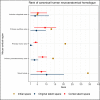Whole-brain comparison of rodent and human brains using spatial transcriptomics
- PMID: 36342372
- PMCID: PMC9708081
- DOI: 10.7554/eLife.79418
Whole-brain comparison of rodent and human brains using spatial transcriptomics
Abstract
The ever-increasing use of mouse models in preclinical neuroscience research calls for an improvement in the methods used to translate findings between mouse and human brains. Previously, we showed that the brains of primates can be compared in a direct quantitative manner using a common reference space built from white matter tractography data (Mars et al., 2018b). Here, we extend the common space approach to evaluate the similarity of mouse and human brain regions using openly accessible brain-wide transcriptomic data sets. We show that mouse-human homologous genes capture broad patterns of neuroanatomical organization, but the resolution of cross-species correspondences can be improved using a novel supervised machine learning approach. Using this method, we demonstrate that sensorimotor subdivisions of the neocortex exhibit greater similarity between species, compared with supramodal subdivisions, and mouse isocortical regions separate into sensorimotor and supramodal clusters based on their similarity to human cortical regions. We also find that mouse and human striatal regions are strongly conserved, with the mouse caudoputamen exhibiting an equal degree of similarity to both the human caudate and putamen.
Keywords: comparative neuroanatomy; evolutionary biology; human; mouse; neuroinformatics; neuroscience; translational neuroscience.
Conflict of interest statement
AB, YY, BD, AR, RM, JL No competing interests declared
Figures











Similar articles
-
Whole brain alignment of spatial transcriptomics between humans and mice with BrainAlign.Nat Commun. 2024 Jul 30;15(1):6302. doi: 10.1038/s41467-024-50608-2. Nat Commun. 2024. PMID: 39080277 Free PMC article.
-
Mapping brain-wide excitatory projectome of primate prefrontal cortex at submicron resolution and comparison with diffusion tractography.Elife. 2022 May 20;11:e72534. doi: 10.7554/eLife.72534. Elife. 2022. PMID: 35593765 Free PMC article.
-
Comparative neuroimaging of sex differences in human and mouse brain anatomy.Elife. 2024 Mar 15;13:RP92200. doi: 10.7554/eLife.92200. Elife. 2024. PMID: 38488854 Free PMC article.
-
Spatial Transcriptomics: Molecular Maps of the Mammalian Brain.Annu Rev Neurosci. 2021 Jul 8;44:547-562. doi: 10.1146/annurev-neuro-100520-082639. Epub 2021 Apr 29. Annu Rev Neurosci. 2021. PMID: 33914592 Review.
-
Striatal tissue transplantation in non-human primates.Prog Brain Res. 2000;127:381-404. doi: 10.1016/s0079-6123(00)27018-0. Prog Brain Res. 2000. PMID: 11142037 Review.
Cited by
-
A Review of the Application of Spatial Transcriptomics in Neuroscience.Interdiscip Sci. 2024 Jun;16(2):243-260. doi: 10.1007/s12539-024-00603-4. Epub 2024 Feb 20. Interdiscip Sci. 2024. PMID: 38374297 Review.
-
Temporal fingerprints of cortical gyrification in marmosets and humans.Cereb Cortex. 2023 Aug 23;33(17):9802-9814. doi: 10.1093/cercor/bhad245. Cereb Cortex. 2023. PMID: 37434368 Free PMC article.
-
Revolutionizing cardiovascular research: Human organoids as a Beacon of hope for understanding and treating cardiovascular diseases.Mater Today Bio. 2024 Dec 9;30:101396. doi: 10.1016/j.mtbio.2024.101396. eCollection 2025 Feb. Mater Today Bio. 2024. PMID: 39802826 Free PMC article. Review.
-
The life and times of endogenous opioid peptides: Updated understanding of synthesis, spatiotemporal dynamics, and the clinical impact in alcohol use disorder.Neuropharmacology. 2023 Mar 1;225:109376. doi: 10.1016/j.neuropharm.2022.109376. Epub 2022 Dec 11. Neuropharmacology. 2023. PMID: 36516892 Free PMC article. Review.
-
A Cross-Species Neuroimaging Study of Sex Chromosome Dosage Effects on Human and Mouse Brain Anatomy.J Neurosci. 2023 Feb 22;43(8):1321-1333. doi: 10.1523/JNEUROSCI.1761-22.2022. Epub 2023 Jan 11. J Neurosci. 2023. PMID: 36631267 Free PMC article.
References
-
- Beauchamp A. MouseHumanTranscriptomicSimilarity. swh:1:rev:0ad9c547e18e8ca5d08872cbecb9f729a4b8b62bSoftware Heritage. 2022 https://archive.softwareheritage.org/swh:1:dir:87ac33008a77aab2bde8b2c85...
-
- Benjamini Y, Hochberg Y. Controlling the false discovery rate: a practical and powerful approach to multiple testing. Journal of the Royal Statistical Society. 1995;57:289–300. doi: 10.1111/j.2517-6161.1995.tb02031.x. - DOI
Publication types
MeSH terms
Grants and funding
LinkOut - more resources
Full Text Sources
Miscellaneous

